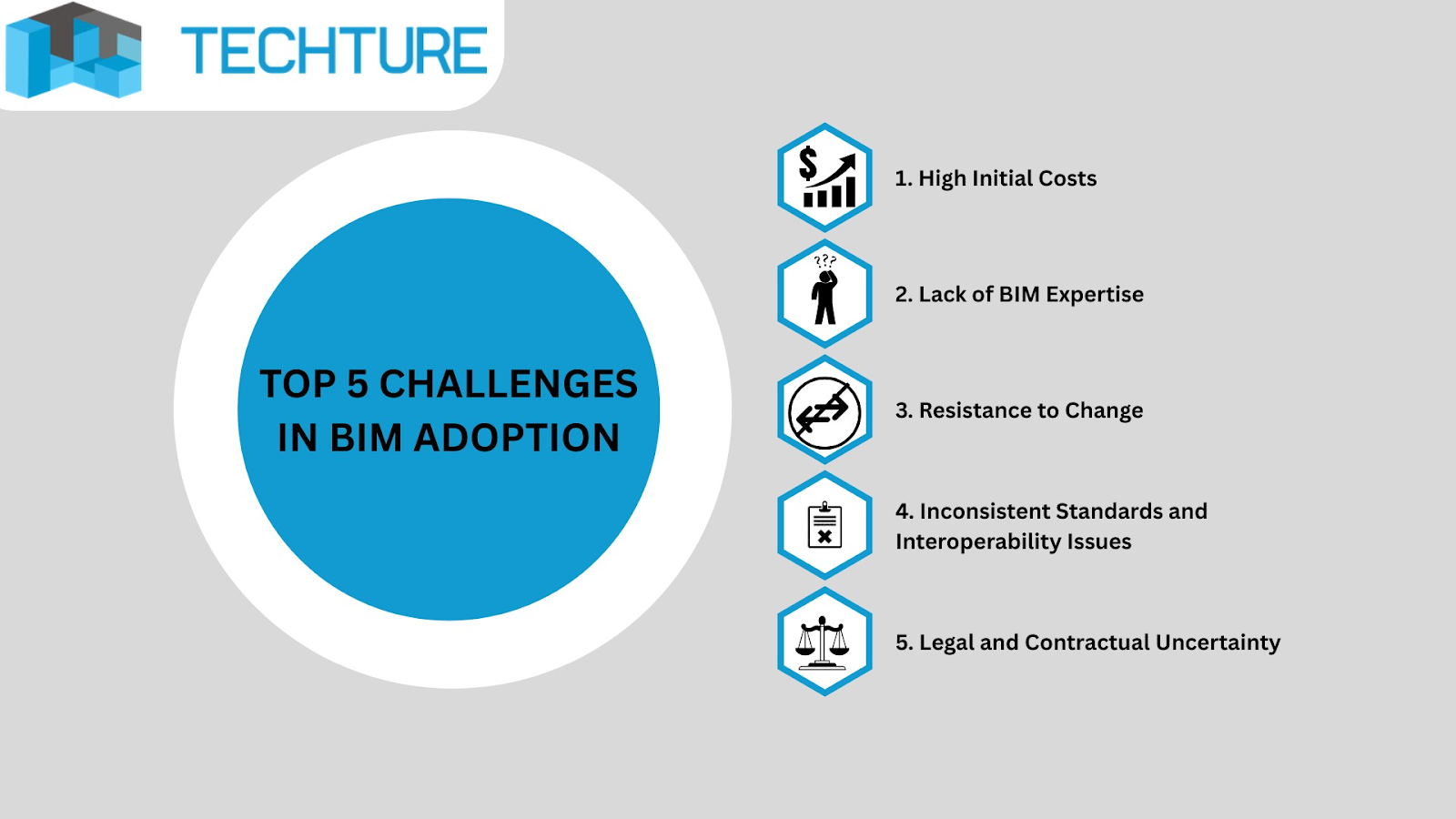
Introduction
In the fast-paced world where every single industry is facing a huge and wide wave of digitalization, the Construction and infrastructure industries in North America are one of its major examples. At the center of this evolution is Building Information Modeling (BIM), which enables you to integrate design, engineering, and construction data into a single, collaborative model.
As the private stakeholder and government demand for efficient, sustainable, and transparent construction practices, the BIM adoption is gaining popularity across the USA and Canada. Despite this, BIM implementation still faces significant barriers.
Here, we have tried to pinpoint all the important information about the BIM model and the current state of BIM adoption in the USA and Canada, highlighting the top challenges and practical region-specific solutions that can help AEC professionals and firms successfully embrace BIM.
What is BIM and Why It Matters
BIM stands for Building Information Modeling. It is a 3D model comprised of a data-rich, collaborative process that enables all stakeholders in a project to work on a shared digital representation of an infrastructure asset.
Now, let's dive into the important factors that BIM enables:

Globally, BIM adoption is on the rise because of these benefits. So the USA and Canada represent key growth areas due to their advanced infrastructure needs and the adoption of the BIM model.
Current State of BIM Adoption in the USA and Canada
United States
In the USA, BIM adoption has geared up in both the private and public sectors. The major driver here is the General Services Administration (GSA), mandating BIM use for public building projects since 2007, and now many states include BIM in their infrastructure guidelines.
Major architecture and construction firms already use BIM platforms like Autodesk Revit, Navisworks, and Autodesk Construction Cloud, while smaller ones are rapidly trying to imitate the large firms to catch up to the model.
Canada
Unlike some countries, Canada's use of BIM isn't controlled by a single central authority. It's more of a local effort than a government taking control, with organizations like buildingSMART Canada and the IBC leading the path to establish nationwide standards. In Canada, adoption of BIM is majorly in urban cities like Toronto and Vancouver, particularly for projects in transit and healthcare.
However, only a portion of Canadian AEC firms have fully integrated BIM workflows due to cost and skills-related concerns.
Top Challenges in BIM Adoption

Let's now dive into the following challenges one by one:
1. High Initial Costs
It is one of the biggest hurdles in BIM adoption. Investing in BIM software (like Revit or ArchiCAD), high-performance hardware, and team training can be highly expensive, especially for small- to medium-sized organizations. Because their primary goal is to save money, irrespective of long-term savings
2. Lack of BIM Expertise
There is a huge gap in both the USA and Canada. Many AEC professionals have limited exposure to this BIM software. Additionally, a few institutions offer formal BIM education. This ultimately leads to slow adoption rates and increased dependency on external consultants, which ultimately costs a lot.
3. Resistance to Change
The major roles for this limitation are due to senior professionals, because the transition from traditional 2D CAD workflows to BIM requires a cultural shift, and the senior professionals are resistant to adopting, resulting in even well-funded initiatives often losing momentum.
4. Inconsistent Standards and Interoperability Issues
The lack of uniform BIM standards across states, provinces, and organizations causes serious interoperability issues. Teams use different incompatible tools or definitions of Level of Development (LOD), resulting in poor coordination.
Integrating it with legacy tools is often complex and time-consuming for the firms.
5. Legal and Contractual Uncertainty
BIM has raised the concern of data ownership, liability, and intellectual property. In many North American contracts, there is still no clear framework for handling these issues legally. This makes firms hesitant to fully adopt BIM, fearing potential risks related to errors or misuse of shared models.
Practical Solutions to Overcome BIM Adoption Challenges

1. Strategic Investment Planning
Firms can implement BIM in parts rather than implementing it all at once. Starting with small pilot projects and using cloud-based or subscription models can significantly reduce the financial barrier. Some scalable options tailored to different firm sizes. Are Autodesk Construction Cloud or Trimble Connect
2. Upskilling and Training
Encouraging in-house training and mentorship programmes can build long-term BIM capability. For these, partnering with colleges and online platforms can fill the gap. In North America, many institutions now offer BIM certifications, and industry events like BILT North America can provide exposure to the BIM enthusiast.
3. Change Management & Leadership
Appointing BIM champions and offering incentives for digital transformation helps drive adoption. In a way, employees and professionals will enjoy their journey with a sense of responsibility to build a community, and telling them the time/cost savings through BIM ROI case studies can help overcome resistance from leadership and traditionalists.
4. Adopt Common Standards
Following internationally recognized standards like ISO 19650, BIM Forum LOD Specifications, or openBIM principles improves interoperability & collaboration.
Many government agencies support these frameworks, making it easier to align and boost the adoption of BIM Modeling
5. Clarify Legal Frameworks
Creating well-structured BIM Execution Plans (BEPs) and using standardized contract templates (such as AIA E203 and G202) can mitigate legal risks.
Reducing the conflict risk of model ownership, liability, and data sharing, ensuring clarity & trust between stakeholders & organizations.
BIM Success Stories in the USA and Canada
USA: GSA’s BIM-Driven Public Buildings
The General Services Administration mandates BIM for many public building projects. And one of the notable successes was the renovation of the U.S. Embassy in London, which reduced design errors by 25% and improved energy modeling with the use of BIM.
Canada: Metrolinx Transit Expansion
Metrolinx, Ontario’s public transit authority, uses BIM for large-scale rail and station projects. Through BIM, they’ve streamlined coordination between architects, engineers, and contractors, resulting in faster approvals between the stakeholders and cost control.
Key Takeaways and Recommendations
Major Barriers
- High cost of tools and training
- Limited skilled professionals
- Cultural resistance
- Technical interoperability
- Legal uncertainties
Quick-Action Checklist
- Conduct a BIM-readiness audit.
- Train key team members or hire BIM experts.
- Use subscription-based or cloud BIM tools.
- Standardize using ISO or openBIM.
- Create a BIM Execution Plan with legal clarity.
Conclusion
By understanding the regional challenges and applying the right solutions, firms can position themselves for long-term success in a digital construction landscape. The adoption of BIM in the USA and Canada is not just about a tool or a new technique; it's reshaping the AEC industry, collaborating, and delivering.
FAQs
1. Is BIM mandatory in the USA or Canada?
Not completely, but some U.S. federal projects and Canadian provincial agencies require it.
2. How long does BIM implementation take?
It depends on project size and firm maturity, and it may take anywhere from a few months to over a year.
3. Is BIM suitable for small firms?
Yes, especially with cloud-based tools and phased implementation strategies.
4. What’s the ROI of adopting BIM?
BIM can reduce costs by up to 20% through fewer errors, better planning, and lifecycle management.
5. Can I use BIM and CAD together?
Yes, you may use both during the early stages of adoption.



